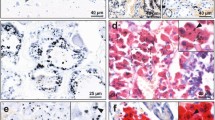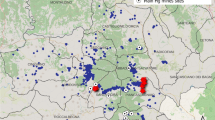Summary
Fourteen Japanese females exposed to elemantal mercury vapour of concentration; 0.001–0.019 mg Hg/m3, were examined for inorganic and organic mercury concentrations in red blood cells, plasma, urine, and hair. Examinations were conducted the times; at 0,4 and 8 months of mercury exposure. No significant change of inorganic and organic mercury in urine was observed for three examinations. Both inorganic and organic mercury in plasma, and only organic mercury in red blood cells, increased significantly after commencement of mercury work. The hair organic mercury values stayed constant. The intake of organic mercury was judged as constant from the constancy of hair mercury values, and the change of organic mercury concentrations in plasma and red blood cells must have been elicited from the intake of elemental mercury. The reason why the increase of plasma mercury values did not reflect to urine mercury values was discussed.
Similar content being viewed by others
References
Clarkson, T.W., Magos, L.: Studies on the binding of mercury in tissue homogenate. Biochem. J. 99, 62–70 (1966)
Ishihara, N., Shiojima, S., Suzuki, T.: Selective enhancement of urinary organic mercury excretion by D-penicillamine. Brit. J. Industr. Med. 31, 245–249 (1974)
Magos, L.: Selective atomic-absorption determination of inorganic mercury and methylmercury in undigested biologial samples. Analyst 96, 847–855 (1971)
Skerfving, S.: Methylmercury exposure, mercury levels in blood, and hair, and health status in Swedes consuming contaminated fish. Toxicology 2, 3–23 (1974)
Sumari, P., Backman, A.L., Karli, P.: Health studies of fish consumers in Finland. Nord. Hyg. Tidskr. 50, 97–102 (1969)
Suzuki, T.: Intake and metabolism of metals in general Japanese populations — Mercury (in Japanese) Igaku no Ayuini 99, 93–97 (1976)
Suzuki, T., Shishido, S.: Change of levels of uinary organic mercury in groups with varying extent of inorganic mercury exposure. Tohoku J. exp. Med. 112, 101–102 (1974)
Suzuki, T., Miyama, T.: Mercury in red blood cells in relation to organic mercury in hair. Tohoku J. exp. Med. 116, 379–384 (1975)
Suzuki, T., Shishido, S., Ishihara, N.: Interaction of inorganic to organic mercury in their metabolism in human body. Int. Arch. Occup. Environm. Hlth. 38, 103–113 (1976)
Suzuki, T., Miyama, T., Katsunuma, H.: Mercury contents in the red cells, plasma, urine and hair from workers exposed to mercury yapour. Ind. Hlth. 8, 39–47 (1970)
Tejning, S.: Mercury content in the blood cells, blood plasma, and hair of heavy fish eaters from different regions. Report 670831 (in Swedish). In; Reports of Clinic of Occupational Medicine, Department of Occupational Medicine, University Hospital, Lund, Sweden (1967)
Author information
Authors and Affiliations
Additional information
Supported by the grant from the Japanese Ministry of Education
Rights and permissions
About this article
Cite this article
Ishihara, N., Urushiyama, K. & Suzuki, T. Inorganic and organic mercury in blood, urine and hair in low level mercury vapour exposure. Int. Arch Occup Environ Heath 40, 249–253 (1977). https://doi.org/10.1007/BF00381412
Received:
Accepted:
Issue Date:
DOI: https://doi.org/10.1007/BF00381412




